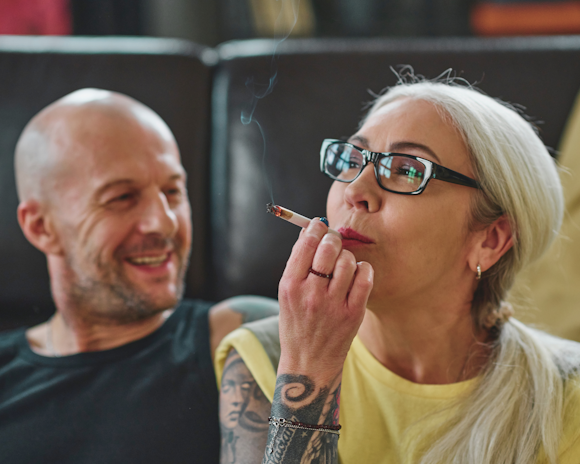
20 THC Mood Enhancement Statistics in 2025
Comprehensive data compiled from extensive research on cannabis wellness and mental health applications
Key Takeaways
- You’re part of a growing movement, but evidence remains limited – Over 3-4 million Americans use medical cannabis, with 50-60% reporting mood-related benefits, though clinical evidence comes from only 112 participants across 8 small trials
- Market growth far outpaces scientific validation – The $38.5 billion US cannabis market expands rapidly while systematic reviews consistently rate mood evidence as “low to very low quality”
- Individual experiences vary significantly – While many patients report subjective benefits, no head-to-head trials compare cannabis with established antidepressants or anxiety medications
- Dosing matters critically for safety – Low doses (7.5mg THC) may reduce anxiety while higher doses (12.5mg) can increase it, with 17.3% of cannabis ER visits involving severe anxiety
- Healthcare provider knowledge gaps persist – Only 9% of medical schools provide adequate cannabis education, leaving patients to navigate treatment largely on their own
- Federal policy remains stalled – Cannabis rescheduling efforts suspended indefinitely despite 90% of public comments supporting change, limiting research and insurance coverage
- Geographic access varies dramatically – Only 5 states include anxiety and 4 include depression as qualifying conditions for medical cannabis programs
- Research funding continues despite barriers – NIDA invested $534 million in cannabis research in 2024, though Schedule I status constrains clinical trials
Understanding the Scope
1. 3-4 million Americans use medical cannabis with 50-60% targeting mood conditions
Currently, over 3-4 million patients are registered in US medical cannabis programs, with Florida leading at 832,000 patients. This represents only registered users and likely underestimates total medical use. Most significantly, 50-60% of medical patients report using cannabis for mood-related conditions, with anxiety affecting 41.8% of all patients and depression affecting 23.9%. If you’re considering cannabis for mood support, you’re joining millions who seek natural alternatives, though clinical evidence remains limited. Source: SAMHSA NSDUH
2. Clinical evidence derives from only 112 participants across 8 small trials
Despite widespread use, a comprehensive review found the entire evidence base for cannabinoids treating mood disorders comprises just 112 participants across eight trials, with five studies including 13 or fewer participants. Multiple systematic reviews, including those from Cochrane and The Lancet, consistently rate evidence quality as “low to very low” using GRADE assessments. This limited evidence base cannot support many therapeutic claims made about cannabis for mood enhancement. Source: PMC Systematic Review
3. US cannabis market reaches $38.5 billion in 2024
The U.S. legal cannabis market reached $38.50 billion in 2024, projected to grow to $76.39 billion by 2030 at an 11.51% compound annual growth rate. This massive growth reflects changing attitudes toward cannabis wellness, though market expansion far outpaces scientific validation. State tax revenues provide verification, with over $4.4 billion collected in 2024 alone. Your interest in cannabis for mood aligns with a rapidly expanding industry, though evidence development lags behind market growth. Source: Grand View Research
4. Medical cannabis patients average 45.5 years old with higher incomes
Analysis of 61,379 medical cannabis patients reveals they average 45.5 years old, are 54.8% male, 87.5% Caucasian, with median household income of $69,481—notably higher than the US median of $70,000. This demographic profile suggests medical cannabis users tend to be older, more affluent adults seeking alternatives to traditional treatments. If you’re in this demographic experiencing mood challenges, you’re part of the typical medical cannabis patient population. Source: Journal Cannabis Research
Clinical Effectiveness Evidence
5. CBD shows moderate anxiety reduction in limited studies
A 2024 meta-analysis found CBD produces a “substantial significant impact” on anxiety with an effect size of Hedges’ g = -0.92, though this derives from just 8 studies with 316 total participants. This represents moderate evidence for CBD’s anti-anxiety effects, but sample sizes remain small. For those considering CBD for anxiety, these results show promise but come from limited research requiring larger, longer-term studies for validation. Source: ScienceDirect Meta-Analysis
6. Depression evidence remains insufficient for clinical recommendations
No high-quality randomized controlled trials exist evaluating cannabinoids as a primary treatment for depression. The UK Medical Cannabis Registry reported depression scores dropping from 16.0 to 8.0 after one month among 129 patients, but this uncontrolled observational study lacks placebo comparison. Without controlled trials, depression benefits cannot be scientifically validated despite patient reports of improvement. Source: PubMed UK Registry
7. No head-to-head trials compare cannabis with standard treatments
Most critically, no studies directly compare cannabis products with established antidepressants or anxiolytics. This means claims about cannabis being equivalent to or better than traditional medications lack scientific support. If you’re considering cannabis instead of prescribed medications, discuss this carefully with your healthcare provider as comparative effectiveness data doesn’t exist. Source: Lancet Systematic Review
8. Dose-dependent effects prove critical for mood outcomes
Research shows low doses of 7.5mg THC can reduce anxiety, while 12.5mg produces significant increases in anxiety and negative mood. This “biphasic” effect means dosing accuracy is crucial for desired outcomes. Products exceeding 10% THC concentration are considered high-potency and associated with increased mental health risks. Understanding these dose relationships helps optimize benefits while minimizing adverse effects. Source: PMC Dose Effects
Safety & Adverse Effects
9. 17.3% of cannabis ER visits involve severe anxiety or panic
Emergency department data reveals 17.3% of cannabis toxicity presentations involve severe anxiety or panic attacks, demonstrating that cannabis can worsen rather than improve mood symptoms. A large Ontario study found 12.3% of individuals with cannabis-related ED visits had subsequent anxiety disorder diagnoses—a 3.7-fold increased risk. These safety data highlight that cannabis isn’t universally beneficial for mood conditions. Source: PMC Cannabis Anxiety
10. Cannabis use disorder affects approximately 9% of users
Cannabis dependency develops in approximately 9% of users, lower than alcohol (24%) but representing real addiction potential. Heavy cannabis use shows 62% increased risk for developing depression (OR 1.62) and elevated social anxiety disorder risk. While dependency rates are relatively low, the risk deserves consideration for long-term mood management strategies. Source: CDC Cannabis Disorder
Product Innovation & Market Trends
11. CBD market grows from $9.14 to $22.05 billion by 2030
The global CBD market totaled $9.14 billion in 2024, expected to reach $22.05 billion by 2030 with a 15.8% CAGR. This explosive growth means more options, better quality, and competitive pricing for consumers. If you prefer non-psychoactive options for mood support, the CBD market expansion provides increasing product variety and availability. Source: Grand View Research
12. THC beverages exceed $1 billion market with 750 brands
The THC beverage market exceeded $1 billion in 2024, with approximately 750 brands nationwide. Many products leverage nanoemulsion technology for faster onset, providing alcohol alternatives for social situations while targeting mood benefits. If you’re looking to reduce alcohol consumption while maintaining social engagement, cannabis beverages offer growing options though clinical validation remains limited. Source: MJBizDaily THC Beverages
13. 49% of CBD users specifically target stress and anxiety
Consumer surveys show 49% of CBD users specifically target stress and anxiety relief, while 42% of Canadian cannabis users report mental health benefits. This consumer demand drives product innovation toward mood-focused formulations, though scientific validation lags behind marketing claims. Products designed for microdosing and specific cannabinoid-terpene combinations proliferate without clinical evidence. Source: Flowhub Industry Statistics
Demographics & Usage Patterns
14. Gender distribution shifts toward female consumers
Medical cannabis patients show 54.8% male and 45.2% female distribution, while general cannabis consumption has shifted toward greater female participation. Women increasingly seek cannabis for wellness and mood support rather than recreational purposes. Female-focused products and marketing reflect this demographic shift toward inclusive wellness applications. Source: Cannabis Research Database
15. Mississippi demonstrates fastest patient growth at 41.5%
Mississippi’s medical cannabis program expanded from 40,000 to 50,000 patients between June 2024 and August 2025—a 41.5% increase demonstrating rapid adoption. This growth pattern reflects increasing acceptance of cannabis as a therapeutic option, though clinical evidence development hasn’t kept pace with patient enrollment growth across state programs. Source: Marijuana Herald Mississippi
Drug Interactions & Medical Considerations
16. Cannabis interacts with 401 medications including antidepressants
Cannabis can interact with 401 medications, including 28 major interactions. CBD and THC inhibit cytochrome P450 enzymes, potentially increasing blood levels of common antidepressants like sertraline and fluoxetine. These interactions can amplify side effects or alter the effectiveness of prescribed medications. Consultation with healthcare providers is essential for safe co-administration. Source: Drugs.com Interactions
17. Heavy cannabis use increases depression risk by 62%
Long-term heavy cannabis use shows a 62% increased risk for developing depression (OR 1.62) according to longitudinal studies. While some users report short-term mood benefits, chronic heavy use may worsen depression over time. This paradoxical effect highlights the complexity of cannabis-mood relationships and the importance of monitoring long-term outcomes. Source: PMC Cannabis Depression
Healthcare Integration Challenges
18. Only 9% of medical schools provide adequate cannabis education
A survey of medical school deans found 66.7% reported graduates were “not at all prepared” to prescribe medical marijuana, with only 9% of medical schools documenting cannabis education in their curriculum. This knowledge gap means patients may need to educate healthcare providers about cannabis benefits and risks. Being an informed patient helps bridge this educational deficit. Source: PMC Physician Training
19. Zero insurance coverage for plant cannabis products
Insurance coverage remains nonexistent for plant cannabis, with 0% coverage from Medicare, Medicaid, or major private insurers due to federal Schedule I status. Only FDA-approved synthetic cannabinoids like Epidiolex receive coverage. Notably, 21% of Medicare recipients currently use medical marijuana despite lack of coverage, with 66% supporting Medicare coverage inclusion. Source: Bernard Cannabis Center
Legal & Regulatory Status
20. Cannabis rescheduling suspended indefinitely despite 90% public support
Cannabis rescheduling efforts are suspended indefinitely as of January 2025, despite HHS recommending Schedule III classification and 90% of 42,000 public comments supporting rescheduling. The DEA process remains stalled pending appeals resolution with no statutory deadline. This regulatory uncertainty maintains research barriers and insurance coverage exclusions while state-legal markets expand. Source: NIDA Research Considerations
Herb Recommended Products:
READ MORE










